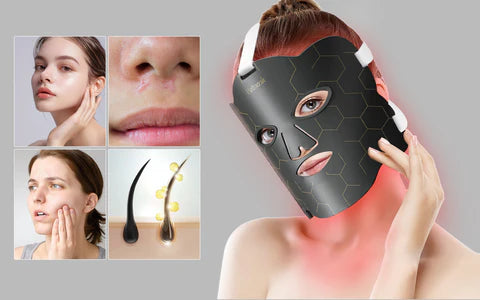If you’ve been dealing with psoriasis and its annoyingly itchy and flaky skin patches, you might feel like you’ve tried everything. Lotions, creams, pills – and yet, those red spots just keep coming back. What if there’s another option to consider that doesn’t involve the usual treatments? Enter red light in therapy: a simple, promising way to help calm your skin down. In this article, we’re going to dig into what psoriasis really is, why the usual treatments might not be enough, and how shining a special kind of light on your skin could make a big difference. Stick with us as we shine a light on all the reasons why red light therapy could be just what your skin needs.

1. What Is Psoriasis Really About?
What’s Going On With Your Skin?
Psoriasis is basically your skin cells working overtime. They multiply way quicker than usual – think a few days instead of weeks. The issue here is, these extra cells don’t have anywhere to go, so they stack up on your skin surface causing those tough, red patches.
Here are the key symptoms to watch out for:
- Red patches covered with thick, silvery scales
- Itchy or burning skin
- Dry, cracked skin that may bleed
- Pitted or ridged nails
Why Does Your Skin Flare Up?
It’s all about your immune system getting mixed signals. Instead of defending against diseases, it starts attacking your healthy skin as if healing a wound or fighting an infection. Various factors can trigger this overzealous response, including:
- Stress
- Certain medications
- Weather changes, particularly cold and dry conditions
- Smoking and alcohol consumption
- Injuries to the skin
How Does Psoriasis Affect Your Life?
Psoriasis is more than just skin deep - it can affect your self-esteem and everyday life. You might feel uncomfortable in social situations or even avoid them altogether. Plus, choosing what to wear can become a major decision.
2. What Treatments Are Available for Psoriasis?
Managing psoriasis usually involves a combination of treatments. While it’s a condition that sticks around, the right treatment plan can significantly reduce or even clear the symptoms from time to time.
Topical Treatments
Topical treatments are creams and ointments applied directly to the skin. They’re often the first line of defense and include:
- Corticosteroids: Commonly prescribed to reduce inflammation and itchiness.
- Moisturizers: Essential for keeping the skin hydrated to prevent cracking and reduce peeling.
- Vitamin D Creams: Help to normalize skin cell growth and can be effective when used on their own or with steroids.
- Retinoids: These contain synthetic vitamin A and can help improve psoriasis symptoms but may cause skin irritation.
How Does Light Therapy Assist in Treatment?
Light therapy, or phototherapy, uses ultraviolet light under medical supervision, and it’s been found to slow skin cell turnover and reduce scaling and inflammation:
- Narrowband UVB Therapy: Targets specific wavelengths of light and is one of the most effective forms.
- Broadband UVB Therapy: Involves a wider range of UV wavelengths but is less commonly used now due to effectiveness and precision advancements with narrowband.
- Psoralen Plus UVA (PUVA): Involves taking a light-sensitizing medication before exposure to UVA light; it’s a more intensive treatment used for severe psoriasis.
What Systemic Treatments Are Available?
For moderate to severe psoriasis, or when topical treatments and light therapy aren’t effective enough, doctors may prescribe systemic treatments. These include:
- Oral Medications: Such as methotrexate or cyclosporine, which suppress the immune system to reduce the rapid turnover of skin cells.
- Biologic Drugs: Targeted drugs administered via injection that block specific pathways in the immune system known to contribute to psoriasis.
3. How Can Red Light Therapy Aid Psoriasis?
Direct Targeting for Psoriasis Relief
Red light therapy masks provide a targeted approach that can alleviate psoriasis patches. By focusing red light on affected areas, the treatment aims to deliver therapeutic benefits where they are most needed, potentially leading to more effective relief.

Stimulation of Skin Healing Processes
The application of red light is thought to penetrate the skin’s surface, which may help in:
- Stimulating Cell Growth: By encouraging new cell growth, red light therapy can aid in the healing process of the damaged skin characteristic of psoriasis.
- Boosting Circulation: Improved blood flow brings more nutrients and oxygen to the skin, which can help reduce inflammation and support skin health.
Inflammation and Redness Reduction
One of the key advantages of red light therapy is its ability to soothe inflammation, a significant factor in psoriasis flare-ups. Consistent use of a red light mask might lead to:
- Decreased Inflammation: Reducing the skin’s inflammatory response helps alleviate discomfort and may diminish the appearance of psoriasis patches.
- Reduced Redness: As inflammation subsides, the redness associated with psoriasis can also be lessened, making the patches less noticeable.
Enhanced Comfort and Convenience at Home
Red light therapy masks offer:
- Ease of Use: These devices are designed to fit comfortably and securely, making them easy to use at home without assistance.
- Convenience: Unlike frequent trips to a clinic, red light masks can be used at your convenience, fitting into your schedule.
Complementary to Existing Treatments
While red light therapy is not a cure for psoriasis, it can complement traditional treatments, potentially enhancing overall results when used in conjunction with:
- Topical Treatments: It may improve the effectiveness of topical creams by promoting healthier skin that can better absorb these medications.
- Systemic Medications: Red light therapy could serve as an additional component in a comprehensive treatment plan that includes oral or injectable psoriasis medications.
Using a red light therapy mask can be a practical addition to your psoriasis management strategy. With their potential to stimulate healing, reduce inflammation, and improve skin appearance, these devices represent a promising supplement to traditional psoriasis therapies. Always consult with your dermatologist before starting any new treatment to ensure it’s appropriate for your specific condition.Read More:Red Light Therapy: Promises and Precautions.
4. When Should You Opt for Red light Therapy Masks in Facial Psoriasis Care?
Deciding when to incorporate red light therapy masks into your facial psoriasis treatment can be strategic for achieving better skin health. Consider these points:
Recognizing Ideal Candidates for Facial Red Light Therapy:
- Those who have persistent facial psoriasis that hasn’t fully improved with topical treatments.
- Individuals looking for a gentle, non-UV treatment option to avoid potential skin damage associated with traditional phototherapy.
- People in need of a targeted approach for delicate areas around the face where applying creams can be challenging.
Situations Where Facial Red Light Therapy Masks Are Beneficial:
- If you’re self-conscious about visible psoriasis patches on your face and seeking an at-home treatment that could reduce redness and inflammation.
- In cases where facial psoriasis tends to flare in response to stress or environmental factors, having a home device allows for immediate and regular treatment, potentially preventing or reducing the severity of flares.
Tips for Blending Red Light Therapy Masks with Current Facial Psoriasis Treatments:
- Consultation is key: Before adding a new treatment to your regimen, especially on sensitive facial skin, discuss it with your dermatologist.
- Introduce slowly: Begin with shorter treatment durations to see how your facial skin responds before progressing to full sessions.
- Careful coordination: Apply red light therapy in conjunction with your existing routine, ensuring there’s no interaction with topicals that may increase skin sensitivity.
- Observe and adjust: Keep a close eye on changes in your condition, and don’t hesitate to report any negative reactions to your healthcare provider immediately.
When considering red light therapy masks specifically for facial psoriasis, personalization and safety are paramount. A thoughtful, well-discussed approach with your dermatologist can lead to a harmonious integration into your skincare routine, offering a convenient way to manage symptoms from home.
Final Thoughts
Seeking relief from the persistent itch and visible patches of facial psoriasis can be a challenge, but red light therapy offers a new layer of hope. This therapy stands out with its simple, home-based approach, targeting the irritation and redness right where it’s needed. It’s not a cure-all, but as we’ve seen, red light therapy brings tangible benefits, such as reducing inflammation and complementing your current skin care routine. If you’re struggling with facial psoriasis and looking for additional support, consider having a chat with your dermatologist about the possibilities red light therapy masks might hold for you. It could be the soothing solution that brings your skin the peace it deserves.






